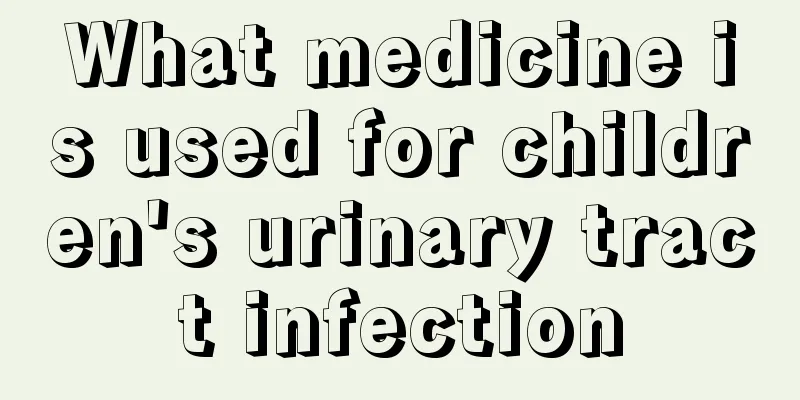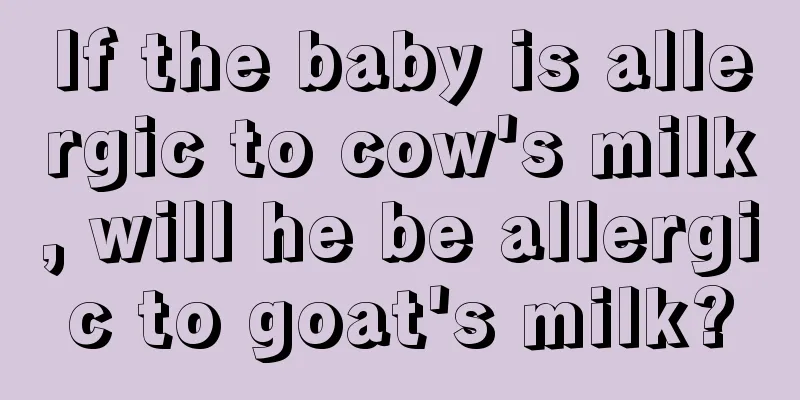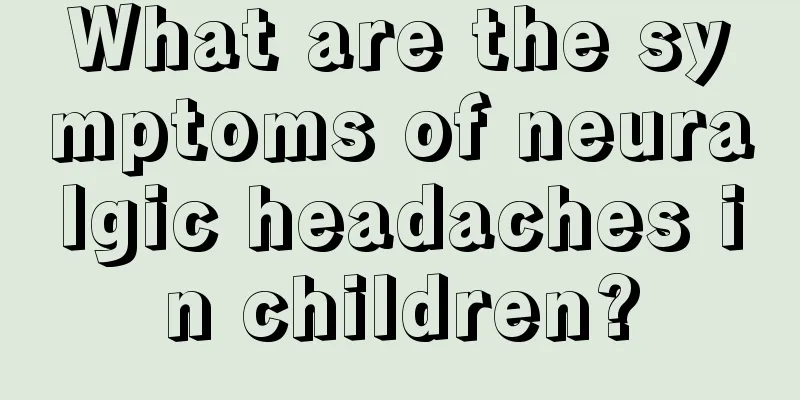What medicine is used for children's urinary tract infection

|
Children's immunity has not been improved, which makes them prone to various diseases, such as urinary tract infection. It is also related to the lack of attention to personal hygiene. Children should develop the good habit of drinking more water and not holding urine, keep the vulva clean, take frequent baths, and change underwear frequently. So what should we do if children have urinary tract infection? What are some good treatment drugs? I will introduce them to you in detail below. Symptoms and signs There are three main manifestations, depending on age and location of urine infection: pyelonephritis, cystitis and asymptomatic bacteriuria. 1. Pyelonephritis is mostly seen in infants and young children, with systemic infection and poisoning symptoms as the main manifestations, often with a fever above 38.5°C. When the fever is high, there may be convulsions or chills. At the same time, there are also general discomfort, listlessness, pale complexion, vomiting, nausea, and mild diarrhea. Older children complain of pain in the ribs or lower back, and percussion pain in the kidney area. Neonatal manifestations include sepsis, weight loss, feeding difficulties, jaundice, irritability, and fever or lack of temperature. 2. Cystitis mostly occurs in older girls, with symptoms of frequent urination, urgency, difficulty urinating, incomplete urination, lower abdominal discomfort, pain in the suprapubic area, urinary incontinence, sometimes foul-smelling urine, and vulvar eczema. Cystitis does not usually cause fever. 3. Asymptomatic bacteriuria Asymptomatic bacteriuria refers to a positive urine culture in children without any clinical symptoms of infection. Almost all of them are girls, but if untreated they may develop into symptomatic urinary tract infections. Medication 1. General treatment: During the acute phase, rest in bed, drink plenty of water, and eat easily digestible food containing sufficient calories and protein. 2. Anti-infection treatment (1) Drug selection: Bacterial urine infection is diagnosed based on the location of the urine infection and the pathogen: ① For upper urinary tract infection, use drugs with high blood and kidney concentrations, and for lower urinary tract infection, use drugs with high urine concentrations. ② Select drugs based on the examined pathogens and their drug sensitivity tests. ③Use low-toxic drugs as much as possible. Infants and young children should receive active and effective treatment. If they have vomiting or weakness, intravenous medication is recommended. Cephalosporin antibiotics, especially second- and third-generation cephalosporins, have better effects. Due to the increasing trend of ampicillin-resistant strains, they are being replaced by amoxicillin/clavulanate potassium (Amoxicillin). Aminoglycosides should be used with caution when given intravenously and should not be given for long periods of time. Quinolones have strong antibacterial effects, but should be used with caution in children under 7 years old. Sulfadimethoxazole (SMZ) and furantoin (furantoin) are suitable for the treatment of lower urinary tract infections and are generally used for 5 to 7 days. Antifungal drugs are available for urinary tract infections caused by fungi. (2) Treatment course: Since cystitis and pyelonephritis in children are difficult to distinguish clinically, and the proportion of urinary tract infections and malformations in newborns and infants is relatively high, short-term treatments, including single-dose treatments and 3-day treatments, are not suitable for promotion in children. Children with acute urinary tract infection who receive short-term therapy have a higher recurrence rate and chance of reinfection than those who receive conventional therapy of about 2 weeks. Short-term therapy is only considered for children over 5 years old and without urinary tract malformations. After effective antibacterial treatment for acute initial upper urinary tract infection, the fever will gradually subside within 2 to 3 days and the urine routine will quickly return to normal. The usual course of treatment is 2 weeks. For those who do not recover well from treatment, antibiotics should be replaced in time based on urine culture and drug sensitivity test. The course of treatment takes 4 to 6 weeks. Midstream urine culture and colony count should be followed up for at least 1 year at 1, 2, 3, 6, and 12 months after recovery from the initial urinary infection. (3) Treatment of recurrence and reinfection: After appropriate antimicrobial treatment, most cases of acute urinary tract infection will disappear and be cured within a few days. However, 50% of children may have recurrences, most of which occur within 1 month after treatment. Common causes include: ① Improper selection of antimicrobial drugs: This includes failure to select drugs that are sensitive to pathogenic bacteria and only selecting drugs with low concentrations in renal tissue, thus failing to achieve effective bactericidal purposes. ② The emergence of drug-resistant strains: This is rare in patients with initial infection. If symptoms and bacteriuria do not disappear within 72 hours after the initial treatment, antibiotics should be replaced in time according to the drug sensitivity results. ③L-type bacteria: account for 20% of the recurrence of pyelonephritis. Since they can only survive under the hypertonic conditions of the renal medulla, their living environment can be destroyed by lowering the osmotic pressure of the renal medulla through drinking more water. At the same time, drugs such as erythromycin and chloramphenicol that inhibit protein synthesis can be used for re-treatment. ④ Urinary tract stones: The presence of urinary tract stones can provide an effective shelter for bacteria, allowing them to escape the killing effect of antibiotics and survive. They often become the cause of recurrence after treatment is discontinued. ⑤ Pathogens: In addition to Escherichia coli, Proteus is the most common pathogenic bacteria. In boys over 1 year old, the pathogens of the initial infection are also mainly Proteus. For these patients, antibiotics should be selected according to drug sensitivity, with large doses and long courses of treatment, at least more than 6 weeks. If bacteriuria persists or relapses frequently after 2 treatments of more than 6 weeks, long-term low-dose antibacterial therapy should be used. It is appropriate to take it once before going to bed every night, and the dose is 1/3 to 1/4 of the conventional treatment dose. Drugs can include sulfamethoxazole (SMZ) + trimethoprim (TMP), amoxicillin, cephalexin or nitrofurantoin (furantanidine), etc., or two of them can be used alternately to prevent the production of drug-resistant strains. Should last 1 year or more. Reinfection often occurs more than one month after initial treatment, often in girls, accounting for 80% of recurrent urinary tract infections. Reinfection is caused by different strains or different serotypes of the same strain of Escherichia coli, and is often accompanied by urinary tract malformations such as urinary tract obstruction and vesicoureteral reflux. Patients with reinfection should first receive conventional treatment for 10 to 14 days. If the symptoms and bacteriuria disappear, they should be followed by low-dose antibiotics to prevent reinfection. Available drugs include sulfamethoxazole (SMZ) + trimethoprim (TMP), nitrofurantoin (furantoin), amoxicillin or cephalexin, etc. The dosage is 1/4 to 1/5 of the conventional treatment dose. If conventional treatment of 10 to 14 days is ineffective, the course of treatment should be extended to 6 weeks. If the patient is effective, continue to use low-dose antibiotics for prevention. If the patient is ineffective or if the treatment is effective at the time but relapses frequently afterwards, long-term low-dose antibacterial therapy should be used. The method is the same as above, and the course of treatment should be at least 1 year. If urinary tract malformation is confirmed, the treatment should be continued until the malformation is corrected or vesicoureteral reflux stops on its own for 1 year. (4) Treatment of asymptomatic bacteriuria: Asymptomatic bacteriuria usually does not require treatment because antibacterial treatment does not reduce the incidence of reinfection. However, if the child has urinary tract malformations such as urinary tract obstruction, vesicoureteral reflux, or old renal scars left by previous infections, active treatment should be given. Otherwise, bacteriuria and coexisting malformations can promote the development of old scars and the formation of new scars, leading to impaired renal function, the formation of renal hypertension, and even end-stage renal failure. For the treatment of asymptomatic bacteriuria, conventional therapy is first used for 10 to 14 days. After the bacteriuria turns negative, low-dose long-term prevention is given. The drug selection, dosage and course of treatment are the same as those for prevention of reinfection patients. (5) Treatment of chronic pyelonephritis: Chronic pyelonephritis often leads to renal cortical scarring, accompanied by deformation and dilation of the renal papillae and renal pelvis and calyces, or persistent renal function impairment and renal contracture. Chronic pyelonephritis is mostly accompanied by vesicoureteral reflux, a few have urinary tract obstruction, and it is extremely rare without deformity. The treatment of chronic pyelonephritis includes conservative medical treatment and surgical treatment. For patients with urinary tract malformations or urinary tract obstruction |
<<: Why does my child always want to urinate but doesn’t urinate much?
>>: Why do children love to blink?
Recommend
How can children grow taller?
The healthy growth of children is what we care ab...
Causes of fever in children on hot days
Although the scenery in summer is beautiful, it i...
What should children pay attention to when swimming?
Swimming can be considered a basic skill, and it ...
Dosage of Ambroxol for Children
The product is mainly aimed at patients with abno...
Cultivating the best emotional intelligence for boys
In the field of education, it is generally believ...
What to do if your child has a fever and convulsions due to the cold
Children usually get a fever due to the cold duri...
Baby's ear is red and swollen
The redness and swelling of the outer contour of ...
What are the symptoms of cerebral palsy?
Cerebral palsy is a disease that is difficult to ...
What to do if your baby only feeds on one side
When breastfeeding, mothers should alternate betw...
What to do if your three and a half year old baby has toothache
When an adult has a toothache, they feel like the...
Why does a child’s lower abdomen feel hot?
Summer is the season when epidemic diseases and v...
What should I do if my one-year-old baby has facial allergies?
When the seasons change, many mothers will find s...
The best time to supplement calcium for infants and young children
Calcium is the most important thing for human gro...
Which month is the golden period for growing taller?
Children nowadays are developing well, and many o...
Child snoring while sleeping
Generally, men will snore after falling asleep la...









